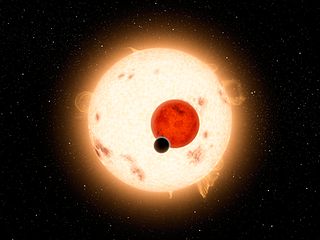Kepler-16
| Doppelstern Kepler-16 | |||||
|---|---|---|---|---|---|
 | |||||
| Kepler-16 System | |||||
| AladinLite | |||||
| Beobachtungsdaten Äquinoktium: J2000.0, Epoche: J2000.0 | |||||
| Sternbild | Schwan | ||||
| Rektaszension | 19h 16m 18,18s [1] | ||||
| Deklination | +51° 5′ 26,8″ [1] | ||||
| Bekannte Exoplaneten | 1 | ||||
| Helligkeiten | |||||
| Spektrum und Indices | |||||
| Veränderlicher Sterntyp | EA + EP[2] | ||||
| Spektralklasse | K7 V [1] | ||||
| Astrometrie | |||||
| Radialgeschwindigkeit | (−32.4 ± 2.6) km/s [1] | ||||
| Parallaxe | 13.29 ± 0.03 mas [1] | ||||
| Entfernung | (245 ± 1) Lj (75) pc | ||||
| Eigenbewegung [1] | |||||
| Rek.-Anteil: | (14.04 ± 0.05) mas/a | ||||
| Dekl.-Anteil: | (−48.6 ± 0.05) mas/a | ||||
| Physikalische Eigenschaften | |||||
| Masse | (0.690 ± 0.004) M☉ [3] | ||||
| Radius | (0.649 ± 0.001) R☉ [4] | ||||
| Effektive Temperatur | (4450 ± 150) K [4] | ||||
| Metallizität [Fe/H] | (−0.3 ± 0.2) [4] | ||||
| Andere Bezeichnungen und Katalogeinträge | |||||
| |||||
Kepler-16 ist ein Doppelstern im Sternbild Schwan. Das System wird von einem zirkumbinären Exoplaneten namens Kepler-16b umrundet.
Sternsystem
Bei Kepler-16 (AB) handelt es sich um spektroskopische Doppelsterne, deren einzelne Komponenten bisher nicht aufgeschlüsselt werden konnten. Das System wird zu den Algolsternen gezählt aufgrund der Bedeckungsveränderlichkeit.

Exoplanet
Kepler-16b ist ein Exoplanet mit einer Masse von etwa 0,3 MJ. Er umkreist die beiden Zentralsterne mit einer Periode von 228 Tagen in einer Entfernung von etwa 0,7 AE bei einer Exzentrizität von etwa 0,007. Kepler-16b wurde mit Hilfe der Transitmethode entdeckt durch das Kepler-Teleskop. Seine Entdeckung wurde im Jahr 2011 veröffentlicht.

Weblinks
Einzelnachweise
- ↑ a b c d e Kepler-16. In: SIMBAD. Centre de Données astronomiques de Strasbourg, abgerufen am 27. August 2018.
- ↑ KID 12644769. In: VSX. AAVSO, abgerufen am 27. August 2018.
- ↑ Nasa Exoplanet Archiv
- ↑ a b c Exoplanet.eu
Auf dieser Seite verwendete Medien
When the smaller star partially blocks the larger star, a primary eclipse occurs, and a secondary eclipse occurs when the smaller star is occulted, or completely blocked, by the larger star.
Autor/Urheber: IAU and Sky & Telescope magazine (Roger Sinnott & Rick Fienberg), Lizenz: CC BY 4.0
IAU Cygnus chart
Opaque red circle
Aside from the eclipsing binary light curve, additional dimming in brightness events, called the tertiary and quaternary eclipses, reappear at irregular intervals of time, the signature of the planet.
From the original caption: NASA's Kepler mission has discovered a world where two suns set over the horizon instead of just one. The planet, called Kepler-16b, is the most "Tatooine-like" planet yet found in our galaxy and is depicted here in this artist's concept with its two stars. Tatooine is the name of Luke Skywalker's home world in the science fiction movie Star Wars. In this case, the planet is not thought to be habitable. It is a cold world, with a gaseous surface, but like Tatooine, it circles two stars. The largest of the two stars, a K dwarf, is about 69 percent the mass of our sun, and the smallest, a red dwarf, is about 20 percent the sun's mass.
Most of what we know about the size of stars comes from pairs of stars that are oriented toward Earth in such a way that they are seen to eclipse each other. These star pairs are called eclipsing binaries. In addition, virtually all that we know about the size of planets around other stars comes from their transits across their stars. The Kepler-16 system combines the best of both worlds with planetary transits across an eclipsing binary system. This makes Kepler-16b one of the best-measured planets outside our solar system.
Kepler-16 orbits a slowly rotating K-dwarf that is, nevertheless, very active with numerous star spots. Its other parent star is a small red dwarf. The planetary orbital plane is aligned within half a degree of the stellar binary orbital plane. All these features combine to make Kepler-16 of major interest to studies of planet formation as well as astrophysics.




